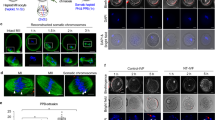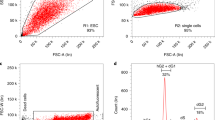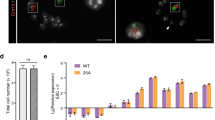Abstract
THE establishment of haploid cell lines in mammals would be of value for studies on developmental biology, genetics and carcinogenesis. It should be possible to produce such lines by culturing cells from haploid parthenogenetic embryos. Only a limited degree of haploid parthenogenetic development has been obtained with mammals1–4, possibly as a result of the effects of deleterious recessive genes in haploid cells. During the process of selection necessary to produce an inbred strain of animals, there may be a reduction in the number of deleterious genes. Haploid embryos from random-bred animals that have not been subjected to the selection that occurs in inbreeding may, therefore, have a lower development potential than haploid embryos from an inbred strain. To test this possibility, we have compared the development of haploid embryos from one inbred strain of golden hamsters with random-bred animals and have found better development of haploid embryos in the inbred animals.
This is a preview of subscription content, access via your institution
Access options
Subscribe to this journal
Receive 51 print issues and online access
$199.00 per year
only $3.90 per issue
Buy this article
- Purchase on Springer Link
- Instant access to full article PDF
Prices may be subject to local taxes which are calculated during checkout
Similar content being viewed by others
References
Beatty, R. A., Parthenogenesis and Polyploldy in Mammalian Development (Cambridge University Press, London, 1957).
Graham, C. F., Nature, 226, 165–167 (1970).
Tarkowski, A. K., Witkowska, A., and Nowicka, J., Nature, 266, 162–165 (1970).
Witkowska, A., J. Embryol. exp. Morph., 30, 519–545 (1973).
Sachs, L., in Current Topics in Developmental Biology, 2 (edit. by Moscona, A. A., and Monroy, A.), 129–150 (Academic, New York, 1967).
Huberman, E., Salzberg, S., and Sachs, L., Proc. natn. Acad. Sci. U.S.A., 59, 77–82 (1968).
Austin, C. R., J. exp. Biol., 33, 338–347 (1956).
Yamagimachi, R., and Chang, M. C., J. exp. Zool., 148, 185–203 (1961).
Longo, F. J., Anat. Rec., 179, 27–56 (1974).
Evans, J. V., Bryant, J. C., Kerr, H. A., and Shilling, E. L., Expl Cell Res., 36, 439–474 (1964).
Tarkowski, A. K., Cytogenetics, 5, 394–400 (1966).
Kaufman, M. H., J. Cell Sci., 13, 553–566 (1973).
Kaufman, M. H., and Gardner, R. L., J. Embryol. exp. Morph., 31, 635–642 (1974).
Sachs, L., Heredity, 6, 357–364 (1952).
Author information
Authors and Affiliations
Rights and permissions
About this article
Cite this article
KAUFMAN, M., HUBERMAN, E. & SACHS, L. Genetic control of haploid parthenogenetic development in mammalian embryos. Nature 254, 694–695 (1975). https://doi.org/10.1038/254694a0
Received:
Issue Date:
DOI: https://doi.org/10.1038/254694a0
This article is cited by
-
Parthenogenetic activation of bovine oocytes using bovine and murine phospholipase C zeta
BMC Developmental Biology (2008)
Comments
By submitting a comment you agree to abide by our Terms and Community Guidelines. If you find something abusive or that does not comply with our terms or guidelines please flag it as inappropriate.



